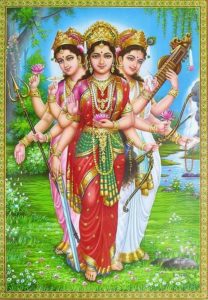Parvati, is the third goddess in the Tridevi or trinity of Goddesses. The tridevi consists of Lasksmi, Saraswati and Parvati. This threesome counter balance the Trimurti, trinity of male gods.
Parvati the wife of Shiva and mother of Ganesha.
She is the goddess of fertility, love, union and devotion and sometimes also referred to as the Mother Goddess. She is the one to turn to for help with marriage conflict, parenting problems, and fertility issues.
She has remarkable strength and determination. Some say that a worship of Shiva is useless without also worshiping Parvati. Parvati is also depicted alongside her husband in more abstract form as the yoni, a vulvular shape, which compliments the phallic linga, which represents Shiva.
The name Parvati is often translated/interpreted as ‘She (daughter) of the Mountain’. She is considered to be a gentle beautiful and benevolent deity.
She seems to be the most recent addition to Hindu goddesses of the three, as she does not appear in ancient, Vedic literature. She is referred to first between 400 BC – 400 AD.
Durga, Shakti, Kali, Tala and Shitala Devi are other, well-known manifestations of Parvati.
When she is pictured with Shiva and Ganesha Parvati is displayed with 2 arms, but when she is pictured alone, she is mostly displayed as having four arms. One hand is in Abhaya mudra of ‘no fear’, another hand holds a variety of weapons (it changes in many pictures) but all these weapons are a symbol of destroying evil and demons. A third hand will hold a lotus (not in full bloom) as a symbol of spiritual evolution. Items in her fourth hand are varied: they could be a bowl of rice or sugar, a rosary, a shell, a mirror, crown or a bell.


